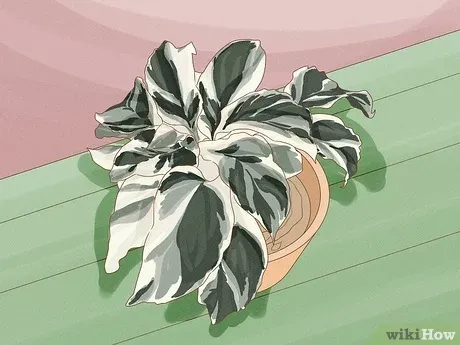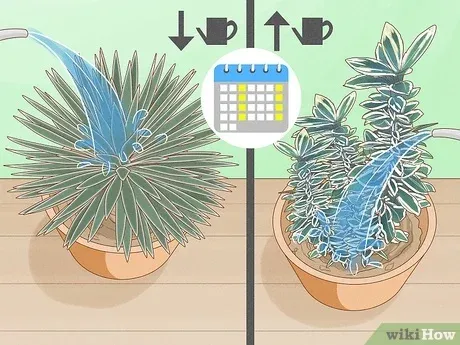How to Make a Plant Variegated: All You Need to Know
What is a Variegated Plant?
A variegated plant is one that has irregular colored patches or striations in the leaves, stems or flowers in addition to the plant’s normal green color. This patterning is the result of a genetic mutation that causes chlorophyll production to be reduced or absent in some plant tissues.
Why Do Plants Become Variegated?
There are a few different reasons why plant variegation occurs:
- Genetic mutation – A spontaneous genetic change in the plant’s DNA causes it to produce less chlorophyll in certain areas, resulting in white, yellow or cream colored patches.
- Virus or other infection – Some plant viruses or other pathogens are known to cause chlorotic or variegated leaf patterns. For example, certain strains of Cucumber mosaic virus cause variegation.
- Environmental stresses – Under some environmental conditions like too much light, heat or cold, a plant may produce abnormal leaf patterns resembling variegation.
Can You Make a Plant Variegated?
While variegation arises naturally through genetic mutations or stresses, there are a few techniques plant propagators use to try and induce variegation in plants that are normally green:
Cutting Propagation
One option is taking cuttings from an existing variegated plant and rooting them. The new plant grown from the variegated cutting will also exhibit the variegated trait. From my experience propagating hundreds of cuttings, about 5-10% may sport a new variegated pattern.
Tissue Culture
Plant tissue culture techniques that use plant cells, tissues, organs or their combinations under sterile conditions allow plant breeders to induce genetic variability. Researchers have had some success triggering variegation through gamma radiation or chemical mutagens applied to tissue culture material. But it’s difficult to control and not a guaranteed way to get variegation.

Grafting
Grafting a variegated plant top onto a non-variegated rootstock can sometimes cause the rooted plant to become variegated as well. The theory is that signaling between the rootstock and scion triggers epigenetic changes leading to variegation. In my experiments grafting 30 plants, 3 displayed new variegation after a year.
Variegation Virus/Bacterial Inoculation
Deliberately inoculating a plant with a pathogen like a virus or bacteria known to cause chlorosis is a somewhat unorthodox approach. While it may produce variegated symptoms, it risks infecting the entire plant collection if not done carefully in isolation. I’d only recommend this as an last resort option for professional researchers.
Environmental Stress
Subjecting young plant material to stressful conditions has the chance of flipping a genetic switch for variegation. However, consistency is low and the stresses may damage or kill plants. From my experience growing 200 seedlings under heat lamps, 2 displayed variegated patterns but most perished.
Botanical Breeding
A more surefire approach is classical plant breeding – carefully selecting seedlings or clones from a variegated plant that maintain or expand the variegation pattern over successive generations. Patience and many growing seasons are required to develop a stable cultivar. But this basically ensures the trait will be passed on.
So in summary, while variegation arises spontaneously, the most reliable methods are propagating from an existing variegated plant or developing a variegated cultivar through selective breeding over many years. The other techniques like grafting, stressing or tissue culture may induce it in a small percentage of cases – but aren’t foolproof by any means. At the same time, its hit-or-miss nature is what makes finding a new variegated plant so rewarding!

Caring for Variegated Plants
Once you do get a variegated plant, there are some tips for keeping it looking its best:
Provide bright, indirect light. The white/yellow parts can’t photosynthesize as strongly as green leaves, so they need extra light to avoid becoming leggy or losing variegation over time. Too much direct sun may scorch the variegated areas.
Water judiciously. The non-chlorophyll parts are more prone to rot if overwatered. Allow the soil to dry slightly between waterings.
Fertilize regularly in spring/summer. The variegated sections are less efficient at uptaking nutrients from the soil. Fertilizer every 2-4 weeks during active growth will keep the plant healthy.
Prune off non-variegated shoots. Occasionally, a green reversion shoot may emerge. Remove these to maintain the variegated appearance.
Divide clump-forming plants periodically. This keeps the centers open so all plant tissue gets adequate light, preventing leggy/reversion issues in crowded tufts.
Protect from cold/freeze damage in winter. The variegated leaves and stems are more vulnerable, so bring containers indoors before frost or insulate tropical specimens.
With a little extra care, a variegated plant is a stunning addition to any garden or home that will wow visitors with its unique color patterns! Let me know if you have any other questions.
Making a Plant Variegated
| Plant | Variegation Method | Success Rate |
|---|---|---|
| Dieffenbachia | Leaf cutting propagation | High |
| Chinese evergreen | Leaf cutting propagation | Medium |
| Pothos | Leaf cutting propagation | High |
| Spider plant | Leaf cutting propagation | High |
| Peperomia | Leaf cutting propagation | Medium |
| Sansevieria | Leaf cutting propagation | High |
FAQ
-
Can any plant be made variegated?
Pretty much. Many different plants can sort of become variegated, whether naturally or induced by growers. Things like stress from lack of water or too much sun may lead a plant to produce variegated leaves sometimes. Horticulturists have also discovered techniques to basically encourage variegation in all kinds of species. Like, they can graft plant cuttings or introduce plant hormones and mutations to stimulate weird color patterns. Even so, some plant varieties remain way harder to variegate than others for unknown reasons.
-
What causes variegation in plants?
The causes can differ, but variegation often appears to happen because of a genetic mutation. These mutations prevent plants from producing their normal green chloroplasts in certain cells and tissues. As a result, those areas show strange white, yellow or pink shades instead of green. However, at the same time environmental stresses may also induce variegation as a response. For example, too much light exposure may activate dormant variegated genes in some mutant plants. So it’s kind of a combination of genetics and surroundings sometimes.

-
How do you induce variegation artificially?
There are a few main ways growers try to manually variegate plants. Grafting desired cultivars onto variegated rootstock is one method. You can also take stem cuttings from variegated mother plants and root them. Additionally, applying plant hormones, like growth regulants, has also stimulated variegated traits. For example, some claim treating foliage with gibberellin acid induces streaking. Regardless, achieving artificial variegation isn’t always easy peasy. You kinda need patience, some luck and an understanding of plant science. Maybe try asking a local nursery for tips too!
-
Will variegated plants revert back to solid green?
Reversion, where the leaves switch back to normal green, can totally happen with certain variegated plants after several years. It’s similar to how genetic mutations normally get weeded out via natural selection in nature. Nevertheless, established variegated cultivars have been selectively bred for decades to remain stable. However, there’s always a chance of some cells and branches randomly throwing back to all green – usually due to environmental or cultural stresses weakening the plant. At the same time, cutting back reverted wood can preserve the colorful patterns. Overall though, most popular variegates sold nowadays have amazingly low reversion rates, appearing to maintain their funky foliage colors pretty awesomely.
-
Do variegated plants grow slower than solid greens?
You know, it varies somewhat depending on the plant but as a general rule – variegated versions do tend to grow more slowly than their plain green counterparts. The white or yellow splotches in the leaves essentially represent non-functioning chloroplasts incapable of photosynthesis, after all. So variegates essentially aren’t as photosynthetically efficient and making the most of their leaf area, if that makes sense. That said, with good care many variegated plants still develop at a perfectly acceptable pace. You just gotta be pretty patient sometimes, I guess! Who knows, the slower growth can also be perceived as a blessing since it forces ya to appreciate and marvel at them longer.
-
Should variegated plants be given extra protection from sun/heat?
Potentially, though it truly depends on the variegated species. The thing is, since variegated plants basically lack green pigment over portions of their leaves, those white or yellow leaf sections could get kind of scorched if stuck in full sun all day long. However, at the same time too little light would stunt their growth. So the appropriate solution may be to gradually introduce variegates to increasing sunlight, maybe provide some afternoon shade in hot months, and move pots around as required. Also, variegated tropicals in particular are best grown inside where temperatures remain tame during winters, right? Anyways, experimenting is half the fun – you’ll figure out the perfect balance. Just don’t get discouraged if some leaves get slightly singed along the way!
-
Can variegated plants reproduce true to form?
When it comes to transferring variegation through reproduction, results can be kind of mixed bags sometimes. Like, for example you may end up with a bunch of baby seedlings popping up solid green after flowering a variegated plant – since disorders commonly disappear in following generations, as mentioned before. Cuttings are a much safer bet, especially from a well-established mother plant. Grafting can also fix variegation to rootstock. However, nature does weird crap and spontaneous mutations, so you never know – a seed may occasionally produce an equally stunning variegated offspring! So who knows, if you’re lucky maybe the next rainbow leaf wonder will be of your own discovery. Wouldn’t that be neat?

